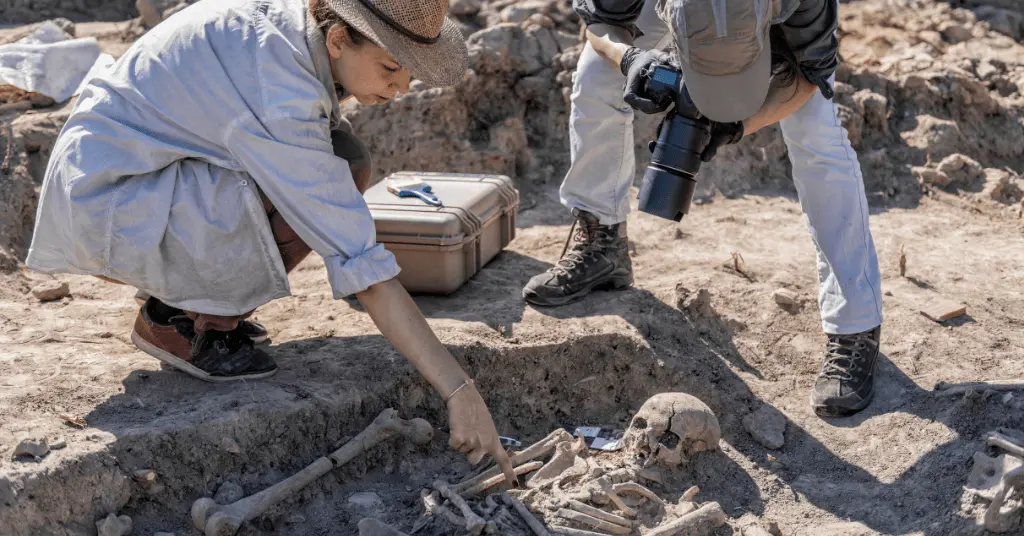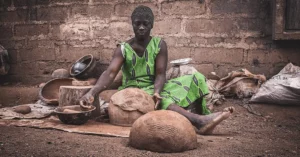AI Answer Evaluation Platform Live Now. Try Free Answer Evaluation Now
Archaeometry
Archaeometry is a set of scientific techniques used in archaeological investigations. It implements principles from physics (radioactivity, magnetism), chemistry (diffusion, reactions,melting) and geology (geomorphology,petrology) in studying archaeological finds.[1] The term comes from a combination of Greek – archaeos (ancient) and metron (measurement). Two main areas of focus in archaeometry include a) dating of artifacts and b) analysis and measurement of artifacts to study their cultural heritage.[2] Archaeometry takes into consideration the physical and chemical properties of artifacts discovered at a site of excavation. Following that, a wide range of laboratory experiments and evaluations are required to trace their origin, source raw material and age. All of this can be used to interpret the context of the site and the social, economical and cultural implications of communities that inhabited it.

Origin and Development
The term was first introduced in the 1950s in Oxford, England. However, the scientific approach in archaeology was present much earlier with analysis of Roman jars and coins in the 19th century to understand their technology.[1] Heinrich Schliemann also scrutinized ceramic beads found in his excavations at Troy in Hissarlik, Turkey. [3]
The advent of radiocarbon dating, discovered by Libby in the 1950s paved the way for accurate dating of organic remains (charcoal, bones, shell etc.) Following such developments, archaeology had undergone the ‘hard science’ transformation and archaeometry became an important inter-disciplinary domain within the field.
To highlight the contribution of archaeometry in studying archaeological finds, we must examine how different types of excavated materials can be analyzed.
Pottery
Ceramic finds demand investigation pertaining to the type of clay and temper used in their manufacturing process. Petrographic scanning using an electron microscope can determine the mineral composition and origin of material used.[1] Additionally, the pigmentations used in motifs and decorations are also scanned for a detailed study.
Archaeometric studies on pottery can help corroborate information regarding their style, typology and shape etc. This helps in understanding past trade networks, availability of raw material and economics of past communities.
Ancient ceramics are dated using Thermoluminescence (TL) method which relies on the nature of objects to absorb environmental radiation. Types of clay in a specimen can be determined by X-ray diffraction method (XRD).
Lithic Artifacts
Lithic analysis is done bearing mineralogical and petrological principles in mind. Tools made of stone can include knives, handaxes, cleavers, arrows, borers and scrapers. Generally the raw material and its properties can be identified based on appearance, streak analysis, color, weight etc. The more extensive procedures include XRD and spectrometry methods to infer the mineral composition of the lithics.
At times, the dimensional aspects of stone tools are also scrutinized to evaluate the manufacturing techniques of ancient people. [4]
Metal Artifacts
Archaeometry of metal artifacts include identification of their trace elements and sources of ores. These compositions can be determined by x-ray fluorescence spectrometry and neutron activation analysis. Lead isotope analysis is also used for certain metals like copper and tin. Additionally, the corroded copper objects like coins and iron artifacts are cleaned using chemical experiments that also enable their preservation.[5]
Organic Remains
Biological remains like bones and teeth can be dated using radiocarbon dating methods. Their age, sex and ethnicity is determined using extensive osteological observations and measurements. Floral and faunal remains also undergo similar scientific procedures. Additionally, biomolecular archaeometry focuses on identifying structural biomarkers using spectrometry.[6] Isotope analysis is conducted on bones and teeth to identify migratory patterns and paleo diets. A wide array of genomic and DNA studies are encompassed in the archaeometry of organic remains.
Conclusion
Archaeometric investigation enables researchers to retrieve information about the past using inter-disciplinary methods. The sub-field is an important feature contributing to the development of archaeology as a scientific study. It is important to consider the physical and chemical properties of archaeological remains. Hence, different types of artifacts and ecofacts have been addressed. The key factor in archaeometry is age-determination and measurement of archaeological finds. This type of evaluation constitutes a holistic approach which inspires an extensively detailed consensus.
See Also
References
[1] Liritzis, Ioannis. (2020). ARCHAEOMETRY: AN OVERVIEW. 10.5281/zenodo.3625220
[2] Musílek, L. (2015). Archaeometry–an example of interdisciplinarity in engineering education. In 43rd Annual SEFI Conference. Orléans, France. Retrieved from https://www.sefi.be/wp-content/uploads/2017/09/54747.-L.MUSILEK.Pdf.
[3] Harbottle, G. (1982) Chemical characterization in archaeology, In: Ericson.J.E., Earle,T.K. (eds) Contexts for prehistoric exchange, Academic Press, London.
[4] Shackley, M. S. (2008). Archaeological petrology and the archaeometry of lithic materials. Archaeometry, 50(2), 194-215.
[5] Rehren, T. (2020). Metals. In M. Richards & K. Britton (Eds.), Archaeological Science: An Introduction (pp. 365-386). Cambridge: Cambridge University Press. doi:10.1017/9781139013826.016
[6] Charrié-Duhaut, A., Philipps, M., & Richardin, P. (2021). Significant advances of ethical considerations in biomolecular archaeometry studies of human remains and related materials. The specific case of mummies hair characterization. Ethics, Medicine and Public Health, 17, 100658.
[7] https://www.uwlax.edu/mvac/process-of-archaeology/lab-analysis/lithic-analysis/




